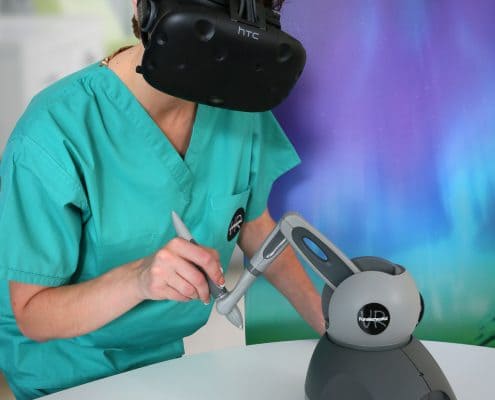Published · Updated
Fundamental Surgery uses a virtual-reality platform to allow hospitals and teaching institutions around the world to utilize the high-quality simulations available through the program.

Led by experts in the field of surgical training as well as leading edge technologists, the mission of Fundamental Surgery and its parent company FundamentalVR is to bring surgical simulations into the hands of medical professionals worldwide, doing so in a way that brings the best software to as many low-cost technologies as possible.
The reason this goal is paramount is simple: it has been proven that surgical simulation is an essential part of a surgeon’s training. Hands-on experience is key, and Fundamental Surgery provides just that. It helps surgeons performing real procedures to become better-prepared and, therefore, see better patient outcomes.
However, surgical simulation comes at great cost. Training on cadavers is extremely expensive and can be very impractical. In the simulation world, hardware and software is often expensive with little results. Fundamental Surgery is one answer to this conundrum. FundamentalVR uses the term “democratized surgical simulation” to describe its offering in Fundamental Surgery.

This kind of democratized simulation gives learners the opportunity to harness simulations day-to-day, allowing surgeons in training and surgeons in general to rehearse their procedures in a controlled environment before performing them for real.
The crux of the offering is the fact that the software is able to be used on virtual reality software that is readily available and that won’t break the bank for prospective users. The software also uses haptics, which simulate the sense of touch, to comprise a system of simulation that any modern computer can use, and that includes laptops. This all adds up to a low hardware investment and a straightforward licensing fee for continued use.

To go a little more in-depth, Fundamental Surgery requires a simple computer and graphics setup along with Windows 10, as well as a virtual-reality headset that qualifies as a Microsoft Mixed Reality Device. These include Microsoft HoloLens, Dell Visor, Lenovo Explorer, Oculus Rift, HTC Vive and Audio Strap and more. Two Geomagic Touch units are required as well for the haptics to work properly. An adjustable-height desk is also recommended for users who wish to use a different operating height than the one they have at their desks.
Fundamental Surgery offers a wide variety of procedures with simple pricing and superb ease-of-use. It allows surgeons to go hands-on before performing a procedure, making the process that much safer for the patient.
Tags: #AR#digitalhealth#futureofhealthcare#healthiAR#medicalvr#orthopedics#surgicalsimulation#XRhealthvr
by kristi · Published November 7, 2016 · Last modified August 13, 2017
by kristi · Published December 9, 2016 · Last modified October 27, 2017
by Angie Banuelos · Published February 23, 2018 · Last modified March 7, 2018
More
Branded Experiences / Device/Demonstration / HTC Vive / Neurology / Oculus Rift
28 Oct, 2016
Clinical Utility / Microsoft HoloLens / Neurology / Surgery
26 Oct, 2016
What do you think?
You are the first to add a thought